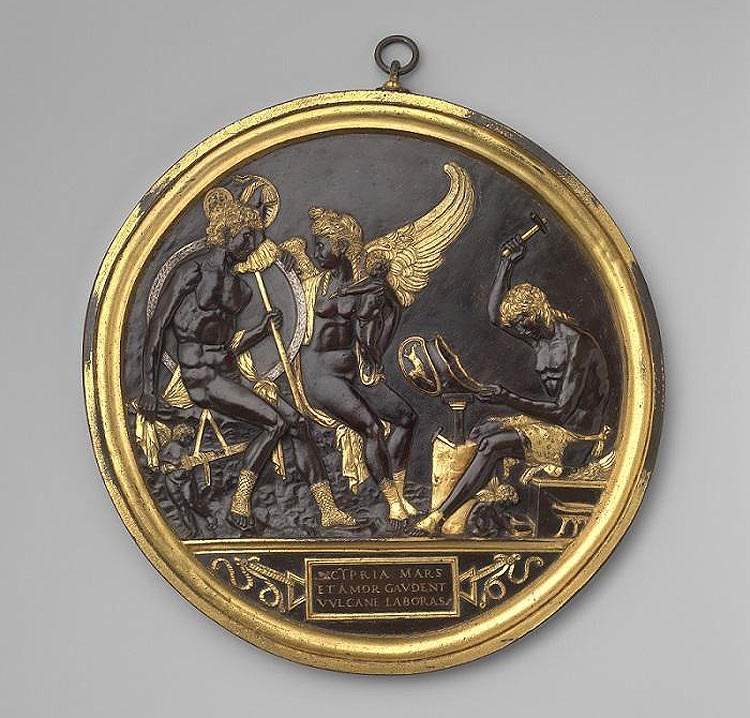Met's strike: purchased a very rare Renaissance bronze tondo by Cavalli
Major acquisition for the Metropolitan Museum of Art in New York, which has secured, for the sum of $23 million, an extremely rare bronze relief attributed to Gian Marco Cavalli (Viadana, c. 1454-post 1508), a goldsmith, sculptor, engraver, and medallist who worked for the Gonzaga family at the court of Mantua. Created around 1500, according to the Met it is both the largest bronze tondo of the period and one of the most technically sophisticated examples. Embellished with gilding and silver inlays, the tondo is decorated with four figures from Roman mythology and provides new data on this particular genre of bronzes produced in northern Italy.
Cavalli’s tondo still retains its frame and a suspension ring so that it can be hung on the wall like a painting, and on a stylistic level it translates a complex pictorial narrative into the sculptural language of gold, silver, and bronze, demonstrating the closely linked relationships between painting, sculpture, drawing, engraving, and goldsmithing at the Gonzaga court. The relief, an allegory celebrating harmony, shows Venus, goddess of love, subduing the belligerent Mars, god of war, to her power. The goddess, depicted with golden wings, is caught capturing Mars with her gaze while her husband Vulcan fabricates the war god’s helmet. The Latin inscription admonishes them, “Venus, Mars and Love rejoice. Vulcan, you toil.” According to Met experts, the highly refined tondo may have been made for Isabella d’Este, Marchioness of Mantua. The attribution of works to Cavalli moreover always remained very complicated until the discovery of this tondo in 2003.
The symbolism of the tondo would suggest a comparison between Isabella d’Este and Venus, following a theme already addressed in the 1497 Parnassus, preserved in the Louvre, painted by Andrea Mantegna for Isabella’s studiolo in the Ducal Palace. Like Mantegna’s painting, the tondo also shows Mars, Venus, Cupid and Vulcan, but in an entirely original conception drawn from a collection of contemporary Gonzaga court poems and popular novels. The tondo’s resonance with art and literature associated with Isabella suggests that she may have commissioned it herself, perhaps to complement the paintings displayed in her studiolo.
“The bronze tondo is an absolute masterpiece, distinguished by its historical significance, artistic virtuosity and unique composition,” said Max Hollein, director of the Met. “This is a truly transformative acquisition for the Met’s collection of Italian Renaissance sculpture. We look forward to exploring and displaying this magnificent work, which makes Cavalli one of the brilliant creators of the Gonzaga court style.”
“Although the Met is rich in paintings and prints by Mantegna and holds the largest collection of gilded and silver-plated bronzes by Pier Jacopo Alari Bonacolsi known as the Antico outside of Europe,” points out Sarah E. Lawrence, head of European sculpture and decorative arts at the Met, “there was no equivalent example in bronze relief in our collection. With this exciting acquisition, the Met is now one of the few museums in the world able to illustrate the crucial collaboration between Mantegna, Antico and Cavalli under the patronage of Isabella d’Este.” Denise Allen, curator of the Department of European Sculpture and Decorative Arts, added, “The sumptuous gilding of the Mantuan tondo, the meticulously inlaid silverwork, and the chiseling so varied and of such high quality identify the tondo as a masterpiece in which Cavalli expressed his superlative skills as a goldsmith and sculptor.”
The acquisition of the tondo was made possible in large part by the extraordinary bequest of the Met’s distinguished curator emeritus of European sculpture James David Draper (1943-2019). Draper led the Met’s efforts to acquire the tondo as soon as it was discovered in 2003, but the museum at the time lost it at auction. At the time he wrote, “This is the most exciting Renaissance bronze to appear on the market in centuries.” Draper spent his 45-year career at the Met building the museum’s collections of 15th- and 16th-century Italian and 18th- and 19th-century French sculpture. He retired in 2014 as curator in the Department of European Sculpture and Decorative Arts. As Executive Director of the Isaacson-Draper Foundation, he generously supported acquisitions, exhibitions, programming, and the Museum’s Thomas J. Watson Library. Major support for the acquisition was also provided by Alejandro Santo Domingo and Michel David-Weill along with other trustees of the Met’s Acquisitions Committee.
The museum plans to display the tondo in Gallery 536 by early March 2022.
 |
| Met's strike: purchased a very rare Renaissance bronze tondo by Cavalli |
Warning: the translation into English of the original Italian article was created using automatic tools. We undertake to review all articles, but we do not guarantee the total absence of inaccuracies in the translation due to the program. You can find the original by clicking on the ITA button. If you find any mistake,please contact us.





























